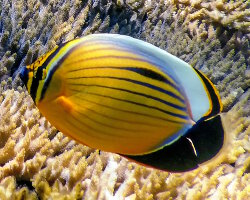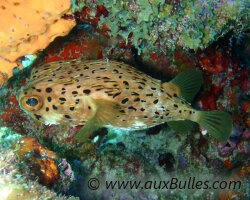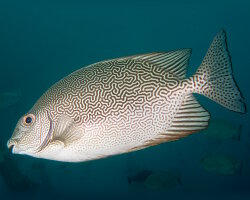Sealife guideThe common stonefishSynanceia verrucosa
Last updated on 02/15/2024 at 11:45 PM
Taxonomy
- Common name: Common stonefish, reef stonefish
- French name: Poisson pierre commun, synancée verruqueuse
- Spanish name: Pez piedra común
- Scientific name: Synanceia verrucosa (Bloch & Schneider, 1801)
- Family name: Synanceiidae
- Order name: Perciformes
- Class name: Actinopterygii
Description
The common stonefish is an expert of camouflage with its brown or grey coloration potentially dotted with numerous irregular yellowish, orange or red spots. A panoply of colors that gives it the appearance of a stone, even a crusted rock or a block of coral !

The common stonefish (Synanceia verrucosa) © David Sanford | Dreamstime.com
The common stonefish has an ovoid body with a total length of around thirty centimeters long. Its mouth is oriented upwards and its dorsal fin is equipped with 13 very strong defensive spines capable of injecting a very powerful poison.
Geographic range
The common stonefish is widely distributed in the warm tropical waters of the Indo-Pacific Ocean and the Red Sea.
It is found in Australia around the Great Barrier Reef and along the eastern coasts of Queensland to the far north of New South Wales.
Habitat
The common stonefish generally frequents rocky or coral bottoms where it lives hidden in crevices or under rocky ledges but it can also be found on sandy bottoms where it buries itself using its large pectoral fins.
Diet
The common stonefish feeds mainly on fish and crustaceans, which it hunts by camouflaging itself in its environment.

A stonefish camouflaged at the foot of a pier hunts on the lookout © Ethan Daniels | Dreamstime.com
The main predators of the common stonefish are sharks and rays.
Did you know ?
The common stonefish has dorsal spines capable of injecting an extremely toxic venom.
The speed with which common stonefish capture prey passing close by is impressive !
The common stonefish is listed as many other marine species within The IUCN Red List of threatened species. The common stonefish appears in the IUCN Red List since 2018 within the category Least Concern !
Tips for observing
The common stonefish is particularly hard to spot in its environment, so keep an eye out !

The stonefish's art of camouflage ! © Ethan Daniels | Dreamstime.com
Discover also

Banded mud moray
(Gymnothorax chlamydatus)
(Gymnothorax chlamydatus)

Blue parrotfish
(Scarus coeruleus)
(Scarus coeruleus)

Eastern red scorpionfish
(Scorpaena jacksoniensis)
(Scorpaena jacksoniensis)

Exquisite butterflyfish
(Chaetodon austriacus)
(Chaetodon austriacus)

Longspined porcupinefish
(Diodon holocanthus)
(Diodon holocanthus)

Starry grouper
(Epinephelus labriformis)
(Epinephelus labriformis)

Tailspot goby
(Amblygobius albimaculatus)
(Amblygobius albimaculatus)

Vermiculate rabbitfish
(Siganus vermiculatus)
(Siganus vermiculatus)
Our latestUpdates

Thursday, January 9th 2025
The lemonpeel angelfish
The lemonpeel angelfish is a small, brightly colored reef fish found in the tropical waters of the Indo-Pacific ocean. It inhabits shallow coral reefs, sheltering among corals and rocky crevices.

Friday, December 19th 2025
The magic of Christmas decorations
Discover Christmas decorations in Florida: giant trees, illuminated palm trees, magical light displays and tropical settings to experience the holiday magic under the sun.

Monday, December 15th 2025
The dusky shark
Discover the dusky shark, one of the world's largest coastal sharks, and learn why this powerful predator is essential to marine ecosystems.
Photo of the Day

Girelle paon à taches d'encre
(Thalassoma hardwicke)
(Thalassoma hardwicke)
